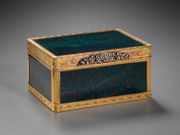Difference between revisions of "Bloodstone"
Jump to navigation
Jump to search
m (Text replace - "== Authority ==" to "== Sources Checked for Data in Record ==") |
|||
| Line 1: | Line 1: | ||
| + | [[File:Bloodstone box-SC327497.jpg|thumb|Bloodstone box<br>MFA# 2013.1740]] | ||
== Description == | == Description == | ||
| Line 7: | Line 8: | ||
heliotrope; chalcedony | heliotrope; chalcedony | ||
| − | == | + | == Physical and Chemical Properties == |
Fracture = conchoidal. Luster = vitreous to waxy. Streak = white. | Fracture = conchoidal. Luster = vitreous to waxy. Streak = white. | ||
| Line 19: | Line 20: | ||
| 2.6 | | 2.6 | ||
|} | |} | ||
| − | |||
| − | |||
| − | |||
| − | |||
== Comparisons == | == Comparisons == | ||
| Line 28: | Line 25: | ||
[[media:download_file_463.pdf|Properties of Common Gemstones]] | [[media:download_file_463.pdf|Properties of Common Gemstones]] | ||
| − | + | ==Resources and Citations== | |
| − | |||
| − | == | ||
| − | |||
* Jack Odgen, ''Jewellery of the Ancient World'', Rizzoli International Publications Inc., New York City, 1982 | * Jack Odgen, ''Jewellery of the Ancient World'', Rizzoli International Publications Inc., New York City, 1982 | ||
| Line 38: | Line 32: | ||
* C.W.Chesterman, K.E.Lowe, ''Audubon Society Field Guide to North American Rocks and Minerals'', Alfred A. Knopf, New York, 1979 | * C.W.Chesterman, K.E.Lowe, ''Audubon Society Field Guide to North American Rocks and Minerals'', Alfred A. Knopf, New York, 1979 | ||
| − | * ''Encyclopedia Britannica'', http://www.britannica.com Comment: "bloodstone." | + | * ''Encyclopedia Britannica'', http://www.britannica.com Comment: "bloodstone." Accessed: 2 Dec. 2004. |
* ''Van Nostrand's Scientific Encyclopedia'', Douglas M. Considine (ed.), Van Nostrand Reinhold, New York, 1976 | * ''Van Nostrand's Scientific Encyclopedia'', Douglas M. Considine (ed.), Van Nostrand Reinhold, New York, 1976 | ||
Revision as of 08:44, 28 August 2020
Description
A semiprecious stone composed of dark green Chalcedony with flecks of red Jasper that were thought to resemble drops of blood. Bloodstones, when submerged in water, give a reddish reflection. These stones are found in Asia, the Hebrides Islands of Scotland, Ethiopia, Egypt, India, and western Europe. Bloodstones were not commonly used in ancient times although occasional cylinder seals have been found (Odgen 1982). During the Middle Ages, bloodstones were used in sculptures to represent flagellation. Bloodstones are currently used as gemstones in jewelry.
Synonyms and Related Terms
heliotrope; chalcedony
Physical and Chemical Properties
Fracture = conchoidal. Luster = vitreous to waxy. Streak = white.
| Mohs Hardness | 7.0 |
|---|---|
| Density | 2.6 |
Comparisons
Properties of Common Gemstones
Resources and Citations
- Jack Odgen, Jewellery of the Ancient World, Rizzoli International Publications Inc., New York City, 1982
- A.Lucas, J.R.Harris, Ancient Egyptian Materials and Industries, Edward Arnold Publishers Ltd., London, 4th edition, 1962 Comment: used from 2200-1200 BC in Egypt
- C.W.Chesterman, K.E.Lowe, Audubon Society Field Guide to North American Rocks and Minerals, Alfred A. Knopf, New York, 1979
- Encyclopedia Britannica, http://www.britannica.com Comment: "bloodstone." Accessed: 2 Dec. 2004.
- Van Nostrand's Scientific Encyclopedia, Douglas M. Considine (ed.), Van Nostrand Reinhold, New York, 1976
- Random House, Webster's Encyclopedic Unabridged Dictionary of the English Language, Grammercy Book, New York, 1997
- The American Heritage Dictionary or Encarta, via Microsoft Bookshelf 98, Microsoft Corp., 1998
